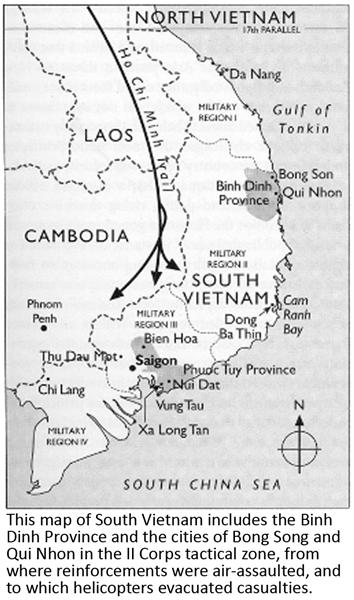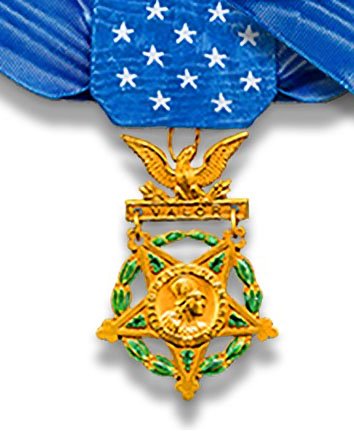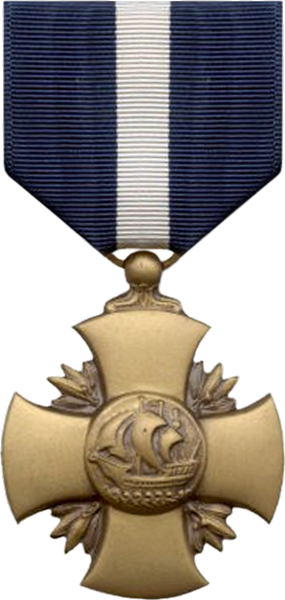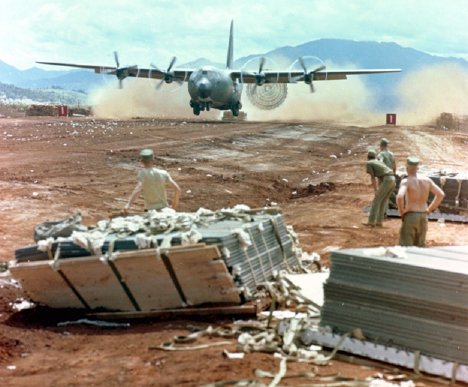The Battle of An Lao, Dec 7-9, 1964
 SUMMARY: The Battle of An Lao was initiated by offensive actions conducted jointly by North Vietnamese Army (NVA) forces and Viet Cong (VC) guerrillas when they captured the An Lao district headquarters in the coastal Binh Dinh province within the II Corps tactical zone, about 300 miles northeast of Saigon. For three days, this joint enemy force successfully repelled large numbers of counterattacking South Vietnamese Army (ARVN) troops. This battle was the first time in northern South Vietnam and the Central Highlands that the NVA and VC "used the new tactic of coordinating main force units with local and guerrilla forces." The battle resulted in 150 NVA and VC killed, 300 ARVN casualties, and deaths of three Americans. For his heroic actions while rescuing wounded Vietnamese soldiers on the first day of the battle, U.S. Army helicopter pilot, Captain Peter R. Coggins, earned both the Silver Star medal and the South Vietnamese Order of Gallantry with Silver Star.
SUMMARY: The Battle of An Lao was initiated by offensive actions conducted jointly by North Vietnamese Army (NVA) forces and Viet Cong (VC) guerrillas when they captured the An Lao district headquarters in the coastal Binh Dinh province within the II Corps tactical zone, about 300 miles northeast of Saigon. For three days, this joint enemy force successfully repelled large numbers of counterattacking South Vietnamese Army (ARVN) troops. This battle was the first time in northern South Vietnam and the Central Highlands that the NVA and VC "used the new tactic of coordinating main force units with local and guerrilla forces." The battle resulted in 150 NVA and VC killed, 300 ARVN casualties, and deaths of three Americans. For his heroic actions while rescuing wounded Vietnamese soldiers on the first day of the battle, U.S. Army helicopter pilot, Captain Peter R. Coggins, earned both the Silver Star medal and the South Vietnamese Order of Gallantry with Silver Star.
FULL STORY: As part of a North Vietnamese strategy change, which incorporated North Vietnamese Army and Viet Cong (VC) guerrilla units conducting joint offensive operations, the An Lao battle commenced early in the morning on December 7, 1964, when Communist forces attacked a South Vietnamese Army (ARVN) position on a hilltop north of the An Lao district headquarters. The battle raged for three days. The United Press International (UPI) identified the offensive as a milestone for the VC, “the first set-piece attack launched by the guerrillas since the beginning of the current civil war.” The Communists poured harassing fire into An Lao’s little garrison of about 50 militiamen, which immediately reported it was surrounded and under heavy recoilless rifle and 81mm mortar fire.
In 1964, many U.S. Army helicopters routinely flew unarmed. The UH-1 Huey configuration designs accommodated 13 passenger seats, or 4 passengers with 6 litters installed, but adding door gunners was an afterthought. Consequently, 31-year-old Army Captain Peter Coggins’ helicopter was unarmed when he set down on a road in front of the garrison to rescue wounded ARVN soldiers. Despite two gunships overhead – UH-1 Huey helicopters armed with heavy machine guns and rockets – Coggins’ helicopter drew a rash of enemy fire. Coggins told the UPI, “We no sooner touched down than a 60mm mortar went off about 30 feet from our left tail. …as we started to move out, another one came in about 30 yards ahead of us.” Coggins recalled that he circled over the mortar fire as an ARVN commander pleaded by radio, “Please come in. We have many, many sick people.” Coggins surmised, “I guess our emotions got the better of us,” and he brought the Huey down again, this time inside the besieged outpost.
The outpost was receiving heavy enemy fire from the surrounding hills and his helicopter had sustained several hits. ARVN soldiers at the outpost were in a state of panic and disorganization, so Coggins instinctively took command of the critical situation as many soldiers rushed the Huey to flee the siege and recalled, “We landed, and good Lord, it was like the hills had opened upon us. [ARVN soldiers] were walking or in slings or carried on doors… some of them weren’t really wounded, so we had to throw them off and make room for the more serious ones.” He lifted off just as another mortar round landed inside the garrison. Coggins and his crew were able to evacuate 11 wounded men.
That night MACV headquarters reported the VC had overrun the command post on hill 193, were threatening An Lao’s subsector headquarters, and remained in the area to fight. Two ARVN companies were missing.
The following afternoon, on December 8, an ARVN battalion of reinforcements arrived on foot, “protected fore and aft by armored personnel carriers.” As the reinforcements snaked their way up the narrow An Lao valley road they were ambushed by NVA and VC attackers in the surrounding hills. Heavy weapons fire wrecked five of the armored vehicles, wounding one U.S. Army advisor and leaving another, Specialist 5 William R. Hamlin, missing.
Hamlin was a 25-year-old Armor Crewman instructor from Seattle, Washington. He had been in the Army four years, and was assigned to MACV’s Advisory Team 2, attached to the 33 ARVN Regiment. In the aftermath of the chaotic ambush, Hamlin was unaccounted for and the unit’s commander reported him missing in action. Two days after the battle, December 11, his body was recovered and identified. He had died as a result of massive trauma and extensive body burns suffered when the NVA/VC ambushed the unit of reinforcements. Presumably, he had been left behind inside one of the five destroyed armored personnel carriers.
Also assigned to Advisory Team 2 and advising the 33d ARVN Regiment 2 was U.S. Army First Lieutenant James G. Dunton. Dunton was mortally wounded by shrapnel when attackers armed with grenade launchers overran the outpost. A Ranger-qualified infantry officer from Melrose, Massachusetts, he entered the Army following his 1962 graduation from Harvard University. Dunton was the son of retired U.S. Navy Rear Admiral Lewis W. Dunton Jr., and twin brother of retired U.S. Navy Captain Lewis W. Dunton III.
Private First Class Arthur A. Shelton was a 21-year-old infantryman from Loyalton, California. Shelton had been in the Army for less than a year, but he volunteered to go to Vietnam as a “shotgun rider,” which in 1964 was a competitive, Top Secret, 90-day temporary duty assignment in which infantrymen were trained as door gunners. The Shotgun program, begun in 1963, was Top Secret because of the sensitivity associated with having combat troops in Vietnam. At the time, the only troops in Vietnam the U.S. Government acknowledged were its “non-combatant” advisors. It was not until 1965 that Army helicopter companies were authorized door gunners as part of their Table of Organization and Equipment.
Officially, Shelton was assigned to the 25th Infantry Division in Hawaii, but on December 8, he was flying “shotgun” as a door gunner on a gunship with the 119th Assault Helicopter Company. The 119th and her sister helicopter company, the 117th AHC, had grouped together 21 helicopters to airlift ARVN troops to regain territory lost to the Communist attackers in the An Lao valley. Along with air support from the Vietnamese Air Force, Shelton’s helicopter repeatedly attacked the sides of the An Lao valley, said to be saturated with enemy. Tragedy struck when single a .30 caliber round from enemy ground fire struck Shelton. He died en route to the hospital at Nah Trang.
Finally, on the third day of fighting, three battalions of ARVN reinforcements – perhaps 1,000 men – were able to retake control of the An Lao valley and the district headquarters. An ARVN division commander credited U.S. air power with saving the day. Intensive air attacks softened up the NVA and VC forces, bombarding An Lao from a hill overlooking the town. Then ARVN troops, under heavy fire, recaptured the hill.
During the Battle of An Lao, in addition to Dunton, Hamlin, and Shelton, there were roughly 300 ARVN casualties, and as many as 700 villagers were temporarily forced to abandon their homes. The North Vietnamese considered the assault a success, insisting in its aftermath that the strategy in the South was now “attack, attack, and only attack.” From a North Vietnamese perspective, the Battle of An Lao marked the official beginning of the Vietnam War.
For his gallant actions while under enemy fire and evacuating numerous ARVN soldiers on December 7, 1964, Coggins was awarded the U.S. military’s Silver Star medal and South Vietnam’s second-highest award for valor, the Order of Gallantry with Silver Star. Coggins’ crew, First Lieutenant Paul Hinds, Sergeant Calvin Ross, and Private First Class Mario Pizzi, each received a Bronze Star medal, and the Order of Gallantry with Bronze Star. Dunton, Hamlin, and Shelton were each posthumously awarded the Purple Heart medal. Shelton also earned two Air Medals, each one accounting for 25 hours of flying in combat. Dunton, Hamlin, and Shelton are memorialized on the Vietnam Veterans Memorial, panel 1E, lines 74 and 75.1
1Pierre Asselin, Hanoi's Road to the Vietnam War, 1954-1965 (Berkeley, CA: University of California Press, 2013), pp. 22 and 204-5; “U.S. Casualties in Vietnam Rise; Reds Fall Back in 3-Day Battle,” New York Times (AP), December 10, 1964, accessed www.nytimes.com/1964/12/10/archives/us-casualties-in-vietnam-rise-reds-fall-back-in-3-day-battle.html; “Pilot Decorated for Daring Rescue in Face of Red Fire,” and Department of the Army, General Orders No. 85 (December 15, 1969), “Peter Coggins Silver Star Recipient,” The Hall of Valor Project (Sightline Media Group), accessed December 7, 2020; “Command History, 1964,” Headquarters, Military Assistance Command, Vietnam, Appendix V, 193; The Coffelt Database of Vietnam Casualties (The Coffelt Group); “Melrose Rites Planned for Viet War Victim,” Boston Globe, December 17, 1964, p. 56; Bob Jones, “3 Schofield GIs Killed, 59 Hurt 'Riding Shotgun',” The Honolulu Advertiser, December 30, 1964, p. 4, https://www.newspapers.com/clip/15252737/19641230-ha-3-schofield-gis-killed/; Brock P. Mauldon and Thomas W. Wright, “The History of the 119th Aviation Company (Air Mobile Light) - 1964,” 52d Aviation Battalion, (U.S. Army Support Command, Vietnam, 1965), www.vhpa.org/unit/119AHC1964.pdf; John Stewart Bowman, The Vietnam War: An Almanac (New York, NY: World Almanac Pub, 1985), 100, accessed December 4, 2020.
Previous This Week in History Articles
2025 | ||
 | Week of May 17 | In early 1969, the Vietnam War was rapidly changing. The 1968 Tet Offensive had shocked the American public, which increasingly demanded an end to the U.S. role in the conflict. At the same time, the number of Americans deployed to Southeast Asia was at its height. ... |
 | Week of May 10 | The Que Son Valley was one of the keys to controlling the northern provinces of South Vietnam, and consequently became the location for numerous engagements between American and Communist troops. The valley was rural but highly populated, with dozens of villages scattered ... |
 | Week of | |
No comments:
Post a Comment